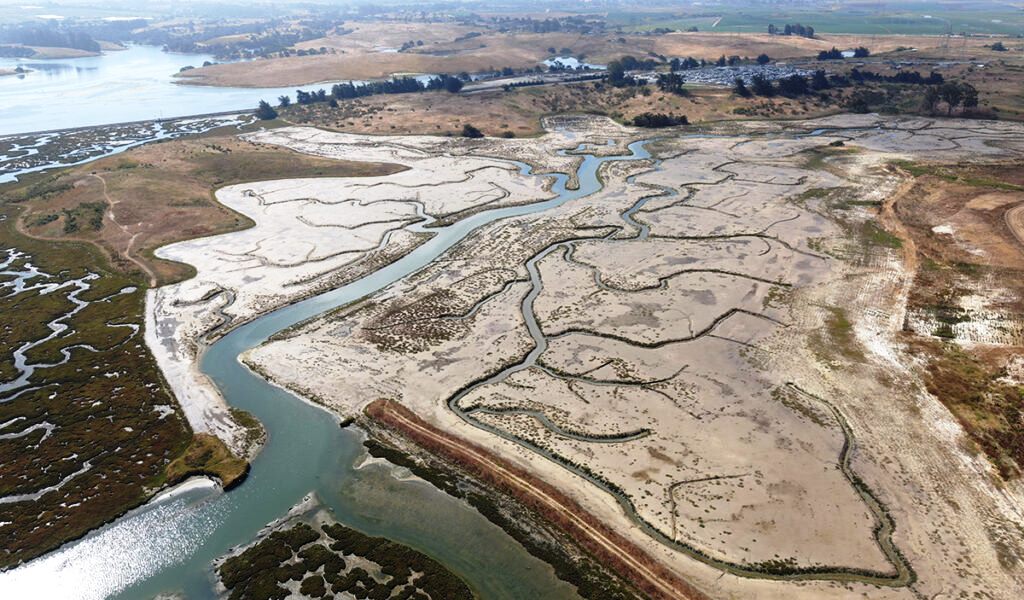On April 21, 2023, the National Oceanic and Atmospheric Administration‘s (NOAA) Coastal Management Office approved $2.2 million in new funding to support a far-reaching restoration initiative at Elkhorn Slough, on the California coast near Watsonville, just south of San Francisco.
The funding, generated by the Bipartisan Infrastructure Law with funding leveraged by the Inflation Reduction Act, will bring back species across an entire coastal landscape—from coastal grasslands to tidal salt marsh, eelgrass beds to native oysters.
This restoration will take place on the Elkhorn Slough National Estuarine Research Reserve, owned and managed by the California Department of Fish and Wildlife in partnership with NOAA and the Elkhorn Slough Foundation.
“With this effort, we’re using a holistic approach to put the puzzle pieces of an ecosystem together and restore an entire coastal landscape,” notes Reserve Manager Dave Feliz.
More than 90 percent of California’s wetlands have vanished over the past century.
Today, Elkhorn Slough features the most extensive salt marshes in California south of San Francisco Bay. Yet without intervention, its remaining marshes are projected to be lost within 50 years due to rising sea levels, subsidence, and tidal erosion.
Tidal salt marshes filter impurities from runoff, recycle nutrients, provide critical habitat, and serve as cradles of biodiversity to young fish, invertebrates, and other wildlife. These marshes are a key part of the rich ecosystem at Elkhorn Slough that supports more than 340 bird, 550 marine invertebrate, and 102 fish species.
Over the past century, the coastal landscapes around this estuary have been highly altered, with habitat lost to diking and species affected by pollution. Iconic species such as pickleweed, eelgrass, and oysters play vital roles in supporting fish, birds, and sea otters as well as in taking up carbon dioxide and pollutants.
Bringing back these species is critical because they each form the foundation of a distinctive coastal habitat, and this effort will employ a unique restoration approach for each species.
Salt marsh will be returned to an area where it was lost due to diking. Dikes cut off tidal waters, the lifeblood of salt marsh habitat, and led to soils drying out and sinking too low for marsh to grow after the dikes were breached.
To reverse this, soil is being scraped from a nearby fallowed farm to raise the elevation back up high enough to support marshes.
“We are building this marsh high enough to last in the face of rising seas, long after most other marshes in the estuary have drowned,” says the Reserve’s Tidal Wetland Program Director Monique Fountain, who is heading up the restoration project as part of a larger, ongoing marsh restoration initiative.
Coastal prairie will be restored to the scraped source areas of soil for the marsh. These areas with fewer weeds provide an opportunity for planting native grassland species before non-native plants become established.
The new grasslands will be home to grasses that grew here for millennia but have become rare in the last century.
Eelgrass, which grows in meadows beneath the tides, will be restored by taking plugs from dense existing beds and bringing them into the newly restored, unvegetated tidal creeks of the marsh restoration area.
Melding eelgrass and marsh restoration is a new approach that researchers hope will benefit both habitat types.
Dr. Kathryn Beheshti, who is leading this component of the restoration, will monitor how eelgrass protects the new creek banks from erosion by slowing wind waves, as well as how the restored habitats provide refuge for commercially valuable fish species and sea otters.
Oysters in Elkhorn Slough are at dire risk of local extinction, with no successful reproduction in the wild since 2012. To restore these vanishing filter feeders, scientists have pursued a novel approach, capitalizing on techniques used by commercial oyster farmers.
They will bring adult oysters from the slough to an aquaculture facility at Moss Landing Marine Labs, where they will be fed and warmed until they produce larvae.
The larvae settle out on clam shells provided by the aquaculturists. When they are dime-sized, the baby oysters will be reintroduced to the restored tidal creeks.
“Oysters have lived in Elkhorn Slough for thousands of years,” notes Reserve Research Coordinator Dr. Kerstin Wasson. “I don’t want them to disappear on my watch.”
Indigenous people harvested oysters from Elkhorn Slough for millennia. Out of respect for this long past relationship, the Reserve invited the Amah Mutsun Land Trust to collaborate in the oyster restoration project.
Members of the tribal band will participate in shellfish restoration and monitoring, deepening a shared connection to coastal resources at Elkhorn Slough and beyond.
“This project will provide the Amah Mutsun Tribal Band with opportunities to connect with wetland habitats and species on their ancestral lands, and I look forward to learning from their perspectives on coastal stewardship,” notes Wasson.
This innovative, integrated approach to coastal restoration will be scientifically designed and monitored so that lessons learned can be shared broadly with other coastal managers.
As the grassland, marsh, eelgrass, and oyster habitats grow, the Reserve will share progress with the local community and with conservation scientists.
Photo courtesy of the Elkhorn Slough Foundation.

